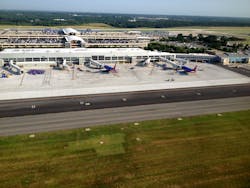4 Considerations for Airfield Pavement Selection
Consulting engineers must think through many considerations before deciding on an airfield pavement selection.
The selection is driven by differing requirements during planning and programming, design, construction, and maintenance throughout the pavement lifecycle. But it is also determined in part by airport officials and project stakeholders, with the selection process functioning as a partnership between client and engineer.
We can best think about the considerations, the questions we will ask and why we ask them – and potential answers to these questions – by using a time-lined approach:
Planning and Programming
The first consideration rests on the funding source and where the pavement is going to be used. The Federal Aviation Administration (FAA), state, local, or private sources may be used to fund these projects, and budgets vary based on project type – whether it’s a rehabilitation or reconstruction.
If there have been problems with a pavement, it might be time to take a clean slate approach with reconstruction. Looking through an airport’s pavement management plan (PMP) and performing on-site inspections can provide an initial picture of the pavement history and current condition.
Bear in mind, though, that reconstruction is more costly. If a pavement is going to be reconstructed, it needs to meet updated standards for geometry and usage, an expensive requirement that does not exist in pavement rehabilitation.
The FAA design criteria recommends designing pavement to last for two decades, but allowances can be made for designing a pavement that will last more or less than 20 years. Justification for these designs is supported by Lifecycle Cost Analyses (LCA), which compare the initial and operating costs of the pavement. More specifically, the LCA looks at the airport’s growth plans and how the airport’s usage will change over that lifespan.
Issues with budget that may arise during the design phase can be avoided with thorough planning and programming, as well as open discussions with the client.
Design
During the design period, it is important to consider how the pavement will be used and to suit the pavement to its intended usage. Is it static loading (parking)? Is it dynamic loading (taxiing)? Will there be fueling or deicing on the pavement requiring additional design considerations?
Flexible or rigid pavement sections have advantages and disadvantages based on the answers to these questions. Thoughtfulness should be provided at each level with funding limitations in mind.
Information about the soil beneath the pavement may be gained from geotechnical sampling and non-destructive analysis can help solve issues with poor soil conditions and determine which base or treatment options should be used. Recycled bases are the most sustainable option. Aggregate bases are used to bring a pavement up to grade and provide support at a lower cost than stabilized materials, which are required by the FAA for use with aircraft weighing 100,000 pounds or more.
Depending on price point, the added use of geosynthetics within the pavement structure can help stabilize soil conditions and provide additional internal support at a lower impact to both time and cost. Geosynthetics do not change the look of the surface materials when the project is completed.
Construction
Though phasing is set for the project during the design stage, it determines how the contractor will sequence the project, how long construction crews have to build it, and how owners are going to keep the airport operating during construction. In this process, we must look at what duration this pavement can be out of service and what the cost and time implications are to minimize operational impacts.
Through discussions with stakeholders, the client must determine what premium they are willing to pay to minimize construction impacts. Multiple smaller phases will allow for increased operational capability of aircraft gates, aprons, or taxiways, but the impact to the contractor’s production efficiency can increase cost and duration.
Also, working in close proximity to active aircraft requires additional safety considerations and coordination. Haul routes crossing active pavements require additional escort, flagging, and FOD inspection/cleaning. Materials such as trackless tack coats have been introduced to minimize contamination of active areas around asphalt paving projects. In some cases moving the project site to a non-airport operations area (AOA) designation through the use of temporary fencing provides an efficiency benefit where operational shutdown can be accommodated.
Clients also need to know if there are qualified contractors in the area available to do the work, or if they will need to be brought in to construct the project. These decisions should be walked through with all airport clients and the stakeholders.
Maintenance
Because airports are going to use this pavement daily, it is important to consider staff familiarity with maintenance and repair alternatives. Airports may be able to utilize in-house maintenance staff depending on the staff’s size and capabilities. Smaller airports that don’t have their own maintenance staff can take advantage of city and county programs that allow them to leverage local resources to maintain the pavement. This local participation can be advantageous for future funding opportunities where grant applications review the work performed by the airport or sponsor.
Time constraints are a point of consideration for maintenance as well as construction. Many commercial service airports can’t afford to shut down runways and other high traffic areas for significant time periods to do maintenance. So, spending more money up front to get a pavement that will operate with minimal downtime may be the best option.
Consulting engineers should walk clients and stakeholders through this decision and the other pavement determinants outlined in the article, so that, together, the client and our aviation experts can make the right decision based on the circumstances.
Matt Schnelle is the Ohio Aviation Leader for RS&H. Based in the firm’s Columbus office, Schnelle has served as a project manager, design engineer, and construction administrator on numerous aviation projects. He can be reached at [email protected].
